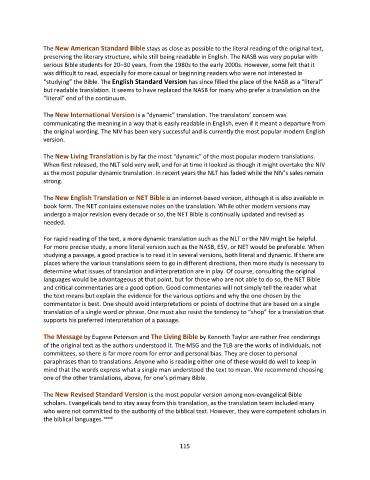Page 117 - Doctrine and History of the Preservation of the Bible revised
P. 117
The New American Standard Bible stays as close as possible to the literal reading of the original text,
preserving the literary structure, while still being readable in English. The NASB was very popular with
serious Bible students for 20–30 years, from the 1980s to the early 2000s. However, some felt that it
was difficult to read, especially for more casual or beginning readers who were not interested in
“studying” the Bible. The English Standard Version has since filled the place of the NASB as a “literal”
but readable translation. It seems to have replaced the NASB for many who prefer a translation on the
“literal” end of the continuum.
The New International Version is a “dynamic” translation. The translators’ concern was
communicating the meaning in a way that is easily readable in English, even if it meant a departure from
the original wording. The NIV has been very successful and is currently the most popular modern English
version.
The New Living Translation is by far the most “dynamic” of the most popular modern translations.
When first released, the NLT sold very well, and for at time it looked as though it might overtake the NIV
as the most popular dynamic translation. In recent years the NLT has faded while the NIV’s sales remain
strong.
The New English Translation or NET Bible is an internet-based version, although it is also available in
book form. The NET contains extensive notes on the translation. While other modern versions may
undergo a major revision every decade or so, the NET Bible is continually updated and revised as
needed.
For rapid reading of the text, a more dynamic translation such as the NLT or the NIV might be helpful.
For more precise study, a more literal version such as the NASB, ESV, or NET would be preferable. When
studying a passage, a good practice is to read it in several versions, both literal and dynamic. If there are
places where the various translations seem to go in different directions, then more study is necessary to
determine what issues of translation and interpretation are in play. Of course, consulting the original
languages would be advantageous at that point, but for those who are not able to do so, the NET Bible
and critical commentaries are a good option. Good commentaries will not simply tell the reader what
the text means but explain the evidence for the various options and why the one chosen by the
commentator is best. One should avoid interpretations or points of doctrine that are based on a single
translation of a single word or phrase. One must also resist the tendency to “shop” for a translation that
supports his preferred interpretation of a passage.
The Message by Eugene Peterson and The Living Bible by Kenneth Taylor are rather free renderings
of the original text as the authors understood it. The MSG and the TLB are the works of individuals, not
committees, so there is far more room for error and personal bias. They are closer to personal
paraphrases than to translations. Anyone who is reading either one of these would do well to keep in
mind that the words express what a single man understood the text to mean. We recommend choosing
one of the other translations, above, for one’s primary Bible.
The New Revised Standard Version is the most popular version among non-evangelical Bible
scholars. Evangelicals tend to stay away from this translation, as the translation team included many
who were not committed to the authority of the biblical text. However, they were competent scholars in
the biblical languages. xxxvii
115

